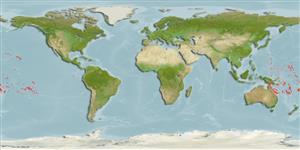Environment: milieu / climate zone / depth range / distribution range
Ecología
marino asociado a arrecife; rango de profundidad 0 - 10 m (Ref. 89707), usually 0 - 3 m (Ref. 9710). Tropical; 30°N - 29°S, 139°E - 123°W (Ref. 5222)
Pacific Ocean: islands of Oceania; Ogasawara Islands, Marcus Islands, Mariana Islands, Marshall Islands, Phoenix Islands, American Samoa, Cook Islands, Line Islands, Society Islands, Rapa, Tuamoto Islands, and the Pitcairn Group. Unknown in Hawaii, the Marquesas, Caroline Islands, nor in any Melanesian islands.
Tamaño / Peso / Age
Maturity: Lm ? range ? - ? cm
Max length : 52.0 cm TL macho / no sexado; (Ref. 9710)
Espinas dorsales (total): 11; Radios blandos dorsales (total): 14-16; Espinas anales 3; Radios blandos anales: 8. Preopercle rounded, finely serrate; upper edge of the operculum sinuous; nostril subequal; maxilla reaches past vertical at rear edge of the eye. Pectoral fins fleshy. Head and body whitish, with small close-set blackish-brown spots, those on the rear part of the body coalesced to form irregular longitudinal bands. Four dark blotches usually at the base of the dorsal fin and a fifth forming a dark saddle blotch on the peduncle. Fins with small white spots and whitish margins, usually with a black submarginal band; body depth contained 2.9-3.4 times in SL; head length 2.4-2.6 times in SL (Ref. 89707).
This shallow-water species is more common on atolls than high islands, and usually found in exposed outer-reef areas. Not dependent on coral cover (Ref. 89707). Juveniles and occasionally adults are collected from tide pools. Feeds on crustaceans (mainly grapsid crabs), octopi, and fishes.
Life cycle and mating behavior
Madurez | Reproducción | Puesta | Huevos | Fecundidad | Larva
Heemstra, P.C. and J.E. Randall, 1993. FAO Species Catalogue. Vol. 16. Groupers of the world (family Serranidae, subfamily Epinephelinae). An annotated and illustrated catalogue of the grouper, rockcod, hind, coral grouper and lyretail species known to date. Rome: FAO. FAO Fish. Synop. 125(16):382 p. (Ref. 5222)
IUCN Red List Status (Ref. 130435)
Threat to humans
Harmless
Human uses
Pesquerías: escaso valor comercial
Más información
Nombres comunesSinónimosMetabolismoDespredadoresEcotoxicologíaReproducciónMadurezPuestaAgregación para la puestaFecundidadHuevosEgg development
ReferenciasAcuiculturaPerfil de acuiculturaRazasGenéticaElectrophoresesheritabilidadEnfermedadesProcesamientoNutrientsMass conversion
Herramientas
Special reports
Download XML
Fuentes de Internet
Estimates based on models
Preferred temperature (Ref.
123201): 25.4 - 29.4, mean 28.1 °C (based on 712 cells).
Phylogenetic diversity index (Ref.
82804): PD
50 = 0.5000 [Uniqueness, from 0.5 = low to 2.0 = high].
Bayesian length-weight: a=0.01175 (0.00571 - 0.02419), b=3.04 (2.88 - 3.20), in cm total length, based on LWR estimates for this Genus-body shape (Ref.
93245).
Nivel trófico (Ref.
69278): 4.2 ±0.64 se; based on food items.
Resiliencia (Ref.
120179): Medio, población duplicada en un tiempo mínimo de 1.4-4.4 años (Preliminary K or Fecundity.).
Fishing Vulnerability (Ref.
59153): Moderate vulnerability (41 of 100).
Nutrients (Ref.
124155): Calcium = 30.2 [14.4, 64.3] mg/100g; Iron = 0.471 [0.249, 1.005] mg/100g; Protein = 18.8 [17.2, 20.2] %; Omega3 = 0.107 [0.064, 0.176] g/100g; Selenium = 23.4 [13.0, 45.6] μg/100g; VitaminA = 206 [53, 793] μg/100g; Zinc = 1.28 [0.86, 1.85] mg/100g (wet weight);
